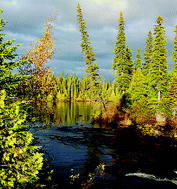Abandoned radar line stations in the North American arctic and sub-arctic regions are point sources of contamination, especially for PCBs. Few data exist with respect to human body burden of organochlorines (OCs) in residents of communities located in close proximity to these radar line sites. We compared plasma OC concentration (unadjusted for total lipids) frequency distribution data using log-linear contingency modelling for Fort Albany First Nation, the site of an abandoned Mid-Canada Radar Line station, and two comparison populations (the neighbouring community of Kashechewan First Nation without such a radar installation, and Hamilton, a city in southern Ontario, Canada). This type of analysis is important as it allows for an initial investigation of contaminant data without imputing any values. The two-state log-linear model (employing both non-detectable and detectable concentration frequencies and applicable to PCB congeners 28 and 105 and cis-nonachlor) and the four-state log-linear model (using quartile concentration frequencies for Aroclor 1260, PCB congeners [99,118,138,153,156,170,180,183,187], β-HCH, p,p′-DDT +
p,p′-DDE, HCB, mirex, oxychlordane, and trans-nonachlor) revealed that the effects of subject gender were inconsequential. Significant differences (p < 0.05) between the groups examined were attributable to the effect of location on the frequency of detection of OCs or on their differential distribution among the concentration quartiles. In general, people from Hamilton had higher frequencies of non-detections and of concentrations in the first quartile (p < 0.05) for most OCs compared to people from Fort Albany and Kashechewan (who consume a traditional diet of wild meats that does not include marine mammals). An unexpected finding was that, for Kashechewan males, the frequency of many OCs was significantly higher (p < 0.05) in the 4th concentration quartile than that predicted by the four-state log-linear model, but significantly lower than expected in the 1st quartile for β-HCH. The levels of PCBs found for women in Fort Albany and Kashechewan were greater than those reported for Dene (First Nation people) and Métis (mixed heritage) of the western Northwest Territories (NWT) who did not consume marine mammals, and for Inuit living in the central NWT (occasional consumers of marine mammals). Moreover, the levels of total p,p′-DDT were greater for Fort Albany and Kashechewan women compared to these same aboriginal groups.


 Please wait while we load your content...
Please wait while we load your content...